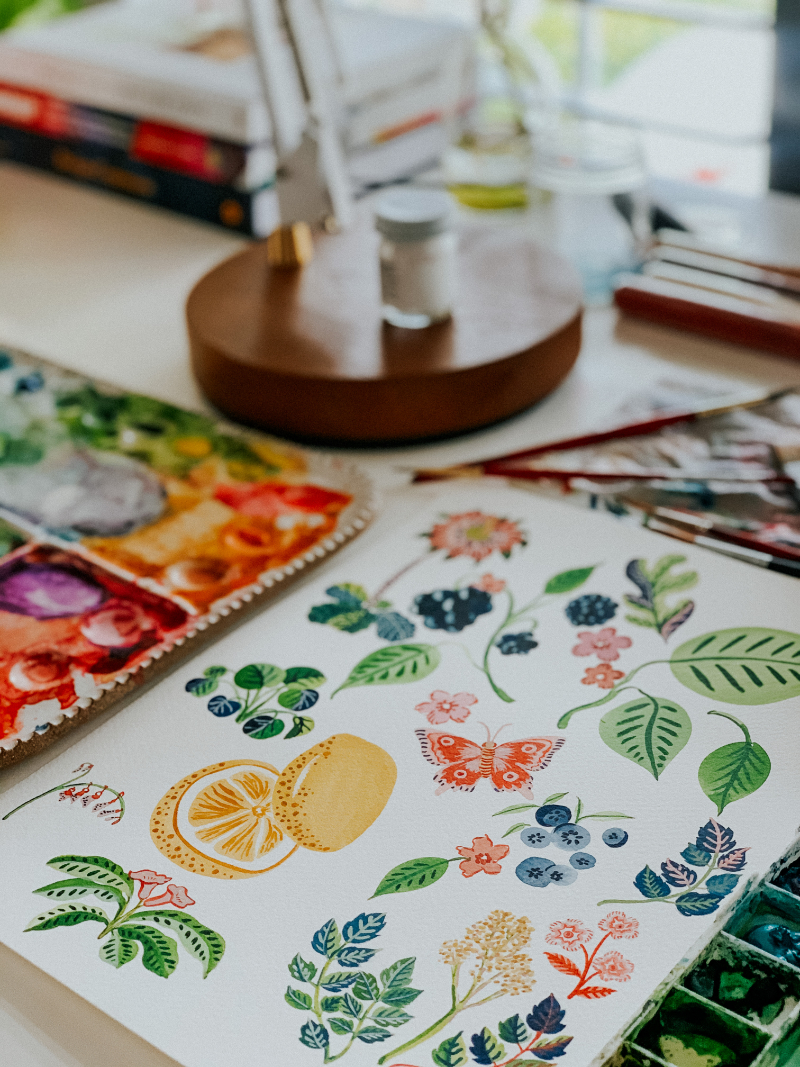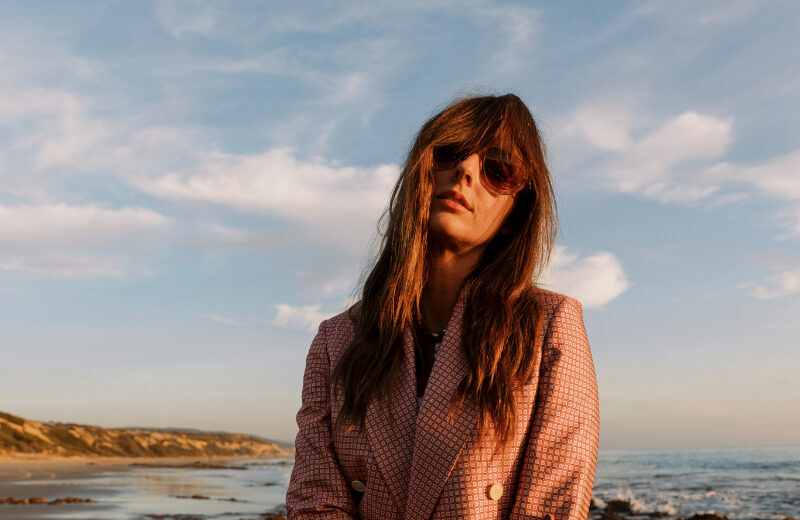We’ve all been there: your paints are ready, your paper’s waiting, and… nothing. Your brain pulls a disappearing act. Suddenly, everything feels too hard or too repetitive. That moment of “what do I even paint?” hits, and if you’re like a bunch of others, the temptation to walk away or scroll instead creeps in.
But here's the good news: inspiration doesn’t always have to come to you, you can create it.
That’s where art prompts become your best creative friend. Whether you’re a watercolor beginner or an artist trying to re-spark your style, prompts remove the pressure to be brilliant and invite you to simply begin.

Why Prompts Work (Even When They’re Random)
Prompts might sound silly at first, like a trick for school kids or a crutch for when you “can’t think of something.” But here’s the truth: prompts are fuel. They create constraints that give your creativity shape. (Which is surprisingly freeing, especially when your brain feels too full or too blank.)
Think of it like this: If someone says, “Paint anything,” your mind races. But if they say, “Paint something soft and round,” your brain starts cooking. Maybe a cloud? A peach? A snail shell?
Art prompts, painting prompts, or drawing prompts remove decision fatigue and open new creative doors.
And when you create your own? That’s where the real magic happens. They’re personal. They reflect your mood, your style, and the stories only you can tell.
5 Simple Methods for Creating Your Own Prompts
There are endless sources of inspiration out there (Pinterest, YouTube, art books) but sometimes, what you really need is a quick, no-fuss way to generate ideas that are yours. Here’s how I create watercolor painting prompts when I’m feeling stuck or want to explore new directions in my art.
1. Use a Word Generator or Journal Entry
Random words can feel like silly play, or like a doorway into something deeper.
Hop onto any free online word generator and grab 1 to 3 words. Let’s say you get: “whisper,” “orange,” and “twist.” Instead of trying to make a literal scene, treat them like a creative puzzle. What feels like a whisper in orange? Maybe a spiral of marigold petals or a slow-turning autumn leaf.
You can also use your own writing, your journal, a dream, or even old grocery lists. Yes, even a list can be inspiring. Imagine painting “milk, figs, thyme” as a still life with a moody color palette.
Prompt Idea: Use a sentence from your journal as the title for your next painting.
2. Let Music Lead the Way
This is one of my favorite ways to generate intuitive art prompts. Music taps into our emotional core. Close your eyes and listen, what colors, shapes, or movements show up in your mind?
Try assigning a playlist to a session:
- Lo-fi chill beats → soft neutrals and floating blobs
- ’70s disco → bold rainbow shapes and sparkle accents
- Nature sounds → organic patterns and gentle washes
Let rhythm shape your brushstrokes or let lyrics influence your subject. This method is amazing for loose watercolor, especially if you’re craving expressive work that isn’t so literal.
Try This: Play a song on repeat and paint the “mood” of that track in just 3 colors.

3. Paint the Unseen
This is your chance to get poetic.
Instead of painting what you see, paint what you feel. These are the most personal and powerful kinds of art prompts. The ones that tap into memory, emotion, and the invisible.
Here are a few to try:
- Paint what your favorite childhood memory looks like as a landscape
- Paint what anxiety feels like in your chest
- Paint the feeling of holding hands for the first time
This kind of work goes deep, and it helps train your eye to look beyond the obvious, which is essential for building your own style. It’s actually something I teach step-by-step inside The Art Within, where we combine foundational drawing skills, color theory, and creative journaling to help you make original art that’s grounded in both skill and self-expression.
You’ll learn how to draw with confidence, study your creative patterns, and build a style journal that becomes your personal idea bank. It’s like art school meets inner exploration, structured, soulful, and totally transformative.
Bonus Prompt: Use wet-on-wet technique to express shifting or “blurry” emotions.
4. Spin the Subject & Style Combo Wheel
Here’s a super practical way to create painting prompts on the fly:
Make two columns:
- Column A: Subjects (butterfly, teacup, tree, waves)
- Column B: Styles or techniques (monochrome, negative painting, pattern-only, loose florals)
Now mix and match. “Butterfly in monochrome.” “Tree made from patterns.” “Loose floral in just shades of blue.”
This trick keeps your watercolor painting ideas playful and fresh. You can even write them on slips of paper and draw at random when you sit down to paint.
Want to take it up a notch? Add a third column for mood (e.g., calm, wild, nostalgic) and you’ve got endless prompt combinations.
PS: This is a great exercise to try alongside my no-pressure watercolor exercises to stretch your style without burnout.
5. Go Outside and Let Nature Pick
Nature is the ultimate source of inspiration, and I shared more about that in this blog, where I talked about how the outdoors invites wonder, observation, and freedom.
To create prompts with nature, try:
- Picking one small item from a walk and painting it from imagination (not just observation)
- Matching a landscape to your current mood
- Choosing a color palette based on the day’s weather
This is especially beautiful when you’re painting en plein air or using your watercolor sketchbook for journaling.
Prompt Idea: Paint the texture of bark and let it evolve into an abstract pattern.
The Magic of Prompting Yourself
Self-generated art prompts remind you that you don’t need to wait around for “the perfect idea.” You are the idea. Your environment, your emotions, your stories—those are your raw materials.
Plus, the more you use your own prompts, the more your style becomes uniquely yours. You’ll notice what themes you return to, what colors keep showing up, what symbols feel natural. This is how you develop voice, not just skill.
And if you want a soft landing to explore that voice? I highly recommend my Favorite No-Pressure Watercolor Painting Exercises. They pair beautifully with your art prompt practice and help build rhythm without expectation.

Want to Shake Things Up Even More?
Sometimes it’s not just the idea, it’s the energy.
If you’re feeling like you’re in a creative rut, try changing how you show up to your art time. New tools, new time of day, even new locations (hello, painting on your porch with tea) can breathe life into a dry season.
In this blog on shaking up your creative routine, I share five playful, doable strategies—from switching up your medium (coffee painting, anyone?) to painting somewhere totally new (like the kitchen floor or your backyard). It’s all about breaking patterns and giving yourself permission to play again.
And yes, I even talk about how to collaborate with your kids or challenge yourself with creative limitations that spark surprising results.
Better yet? Pair all those art prompts with The Creativity Playbook (grab it here) and you’ve got a supportive, playful guide to keep showing up even when the inspiration dips.
Let’s Wrap It Up
Creating your own art prompts is like having a conversation with your inner artist. You’re listening, responding, experimenting. And with every art prompt, you’re telling yourself: “I trust my ideas. I trust my curiosity.”
So next time you’re staring at the paper, instead of giving up, try one of these prompt techniques. Use a word, a song, a memory, or the sky outside your window.
Let it lead you somewhere new.
And if you want company along the way? I’ve got resources, community, and courses to guide you:
Now go prompt yourself into a creative breakthrough!












+ show Comments
- Hide Comments
add a comment